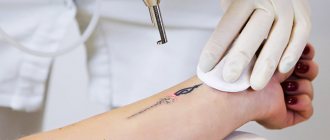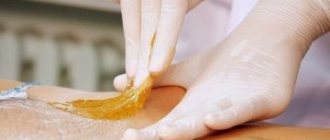A tattoo made during a period of turbulent youth is removed, perhaps more often than others. However, not everyone knows how to do this. Nevertheless, today there are several methods that help get rid of body art that you suddenly don’t like.
A tattoo made during a period of turbulent youth is removed, perhaps more often than others. However, not everyone knows how to do this. Nevertheless, today there are several methods that help get rid of body art that you suddenly don’t like. One of the most famous and effective is a laser procedure. You can even just watch a video of laser tattoo removal and see for yourself the effectiveness of this method. Before that, read our new article, in which we will talk about the main nuances of the procedure.
Is it possible to remove a tattoo?
Some gambling decisions in life, such as tattooing drawings on the body, leave a mark for the rest of their lives and often make their owner regret this action forever.
In search of the right choice, you can waste a lot of time comparing and choosing the removal method that seems more reliable, and even more importantly, safe.
Important: Fortunately, with the help of many years of practice and testing completely different methods, it has become extremely easy to find the answer to all your questions.
If you want to remove a tattoo, first of all you need to remember that you will have to directly interact with the subcutaneous tissue, which consists of adipose and loose tissue, and also includes adipocytes, fibroblasts and macrophages, located under the dermis.
The answer to the question is clear, the tattoo can be removed, but it will require some time to restore the skin, as well as repeated sessions, depending on the type of tattoo, skin and body.
laser tattoo removal
Price
It is generally accepted that the price of laser correction is quite high. In many ways, this statement is true, but it should be remembered that costs to patients can vary greatly and depend on factors such as:
- Size of the treated area.
- The depth of penetration of the coloring composition, its type, and sometimes color.
- Type of laser used.
- Qualification of the specialist performing the manipulations.
| Price per 1 sq. cm | From 300 (total amount from 300) | From 250 (total amount from 1250) | From 200 (total amount from 2000) | From 100 – 150 (total amount from 3000) | From 80 – 100 (total amount from 4000) |
| Tattoo size (sq. cm) | 1 | 5 | 10 | 30 | 50 |
The price given in the table is indicative and determines the cost of one laser correction session. If it is necessary to carry out repeated work, a similar amount will have to be paid again.
Where do tattoos come from?
- Professional removal of tattoos or make-up takes place in establishments providing cosmetic services
- Under the supervision of a specialist, an analysis is made of the area of the body where it will be necessary to remove the tattoo.
Tattoo removal salons are equipped with the necessary equipment for high-quality and effective removal. In particular, the laser is considered the first device for removing tattoos.
- In most cases, salon owners use two types of lasers, selective ruby lasers and neodymium lasers. Their difference lies in the depth of pigment damage, as well as in the price range
- Adapted to the given working conditions, they professionally cope with the task without leaving scars
tattoo removal in the salon
- No less effective ones are relegated to the background: erbium and CO2 lasers. They are also often used in tattoo removal salons, but their functions in a narrow profile differ significantly in quality
Chemical method
This method of tattoo removal is actually a medium or deep chemical peel. An aggressive compound (for example, trichloroacetic acid or phenol) is applied to the area of the skin with the image to be removed, which causes a II-III degree burn and accompanying necrosis of the epidermis and superficial layers of the dermis. The dead layer of tissue is rejected in the form of a scab (crust), followed by gradual healing of the burned surface.
Advantages:
- relative ease of implementation of the technique;
- Suitable for large areas.
Flaws:
- the method is applicable only for superficially located tattoos;
- individual intolerance to the chemical reagent is possible;
- soreness;
- long healing period;
- scar formation;
- high probability of problems similar to post-peeling complications (hyperpigmentation or depigmentation, persistent increase in sensitivity, activation of herpetic infection, exacerbation of acne, etc.).
How to remove a tattoo quickly?
The skin is considered a complex organ that participates in the body’s respiration and provides thermoregulation. Any unprofessional work on it can lead to a number of diseases, not to mention the appearance of the skin.
tattoo removal with acid and scalpel
Important: When raising a question at a consultation with a dermatologist about quick tattoo removal, you should expect a clear answer - it is strictly recommended not to upset the balance of the epidermis by corroding the skin.
By following certain steps that promote gentle tattoo removal, you can achieve more favorable results.
Contraindications to laser removal
There are such prohibitions on this procedure:
- skin diseases (infectious and non-infectious);
- individual sensitivity to ultraviolet radiation - photosensitivity;
- fresh tan that is less than two weeks old;
- neoplasms - malignant and benign;
- pregnancy and breastfeeding;
- epilepsy;
- diabetes;
- keloid scars;
- acute infectious diseases.
The procedure is not performed on clients who have not reached the age of majority.
How to safely remove a tattoo?
The use of a selective laser, surgical cutting or ink removal will damage the skin in any case, so it is impossible to say that tattoo removal is safe.
There are no methods in which the skin is not affected. Each of them leaves behind either pale scars or large scars on the body.
white scars on the face
Mechanical method
Mechanical removal of superficial layers of skin along with tattooing also has a long history. Previously, scraping with a sharp instrument was used for this purpose; now dermabrasion devices are used. They are a cutter - a rotating block with one or more cutting or abrasive surfaces; in some cases, nozzles with hard brushes are used. When performing the manipulation, it is necessary to avoid precisely following the contours of the image, since in this case the resulting scar will follow the shape of the drawing or inscription. To prevent this phenomenon, up to 10 mm of adjacent skin is usually involved.
Advantages:
- the ability to delete drawings that occupy a large area;
- high efficiency.
Flaws:
- pain, which requires anesthesia;
- the method is only suitable for removing superficially located images;
- inability to use on delicate areas (eyelids, genitals);
- long healing;
- relatively high probability of infection;
- almost permanent scar formation.
How to remove tattoos with laser?
- When you make the final decision to have your tattoo removed in a salon, you first need to contact a dermatologist for a consultation. Find out if your skin is suitable for the procedure and what the consequences will be
- While in the salon, the tattoo artist will also diagnose the tattoo. Due to the characteristics of the type of dye, color, depth, as well as the lifetime of the tattoo, an analysis and selection of the necessary equipment for high-quality tattoo removal will be carried out
After collecting the necessary information, the master begins the task.
laser tattoo removal
The pigments are destroyed under the influence of the beam, so the tattoo becomes lightish, and then after a few minutes begins to darken. The destroyed dye will be eliminated by the body over time.
The frequency of procedures will show the consequences instantly. With each new visit to the salon, the tattoo will fade more and more until it disappears completely.
Important: The disadvantages of this procedure include: the duration of the full course of tattoo removal, which can take from two months to several years and the relatively expensive cost of the sessions.
tattoo removal
Are there any side effects?
There are practically no negative consequences after laser tattoo removal. Immediately after the procedure, swelling and redness may appear in the treatment area. After a few hours, these symptoms go away on their own.
It is very rare to experience an allergic reaction to the laser. This side effect occurs in people who are allergic to sunlight. After the procedure, the skin turns red and swelling appears. This allergy can be controlled by taking antihistamines.
Before the procedure, you must undergo a preliminary consultation and warn the specialist about allergies.
How to remove a tattoo at home quickly?
Absolutely all methods are based on imbalance of the skin and its damage, so their main goal is to form an ulcer, which will subsequently remove all harmful and third-party elements, and will later heal.
first laser tattoo removal procedure
Methods for quickly removing tattoos, despite popular discussion and frequent use, are very barbaric, and very often far from fast.
Important: For some tattoos, depending on the amount of ink and lifespan, just two or three sessions are not enough; they require careful supervision for up to two or three months.
Tattoos can be removed using:
- Celandine tinctures. Previously used in the treatment of a wide variety of diseases, celandine tincture also found its place among the drugs used for tattoo removal. Using a tincture, a small area of skin is treated, then a burn is formed, the top layer of skin is removed and a scar is formed at the site of the burn.
It is worth clarifying that celandine is a poisonous plant and its use will definitely cause significant harm to health, and after its use it will be necessary to disinfect the wound and apply a protective bandage.
- Milk. The required amount of milk is injected under the skin, sufficient to cause it to react with the paint pigments. The area of application rots, and after a while a scar forms
- Salt. The procedure has become popular due to its simplicity and degree of consequences. To get started, to disinfect the tattoo area, it is thoroughly washed and cleaned with hydrogen peroxide. The second step is to mix salt with water to obtain a porridge-like consistency, which must then be applied to the problem area and rubbed in with a sponge for twenty minutes.
- Clean the work area again with cool water and carefully bandage it
- If you follow the rules in detail, after 2-3 procedures that need to be performed daily, the first effect will be noticeable
- Regarding the disadvantages, we can say that it is very difficult to undergo such a procedure, since the salt reacts with damaged skin and causes great pain
Disguise (camouflage) tattoo
In this case, the tattoo is not removed, but is camouflaged by injecting a dye over and around it that has a tone close to the patient’s skin color. This method is one of the oldest; it is used to hide small-area designs applied with light paints, as well as to correct an unsuccessful permanent (cosmetic tattoo).
Advantages of the method:
- simplicity;
- minimal trauma.
Flaws:
- even with the most careful selection of dye color, the treated area of skin will differ from the surrounding area;
- The method is not suitable for images that have a large area and are painted in bright colors.
How to remove a tattoo with potassium permanganate?
A layer of manganese powder is applied to the surface of the tattooed area of skin, then thoroughly moistened. For high-quality moisturizing, it is recommended to use a spray bottle.
After the powder reacts with water, it is necessary to apply a plastic film. Depending on the type of tattoo, the procedure can take from two to four hours, after which the bandage is removed.
tattoo removal using potassium permanganate
- Due to the long-term effect of potassium permanganate on the surface of the skin, the epidermis, as well as the dermis containing the dye, is corroded
- It is recommended to rinse the area where the ulcer forms thoroughly with water, and then lubricate it with an antiseptic and healing ointment.
- Active ventilation also has a negative effect on the ulcer, so before going outside, it is recommended to apply a protective bandage
- Potassium permanganate is used for medicinal purposes for disinfection, but it also has many other effects, which is why it is very popular
- It is necessary to carefully dose the amount of the drug and the duration of action when removing a tattoo, as irreparable damage to skin tissue can be caused
Recovery after the procedure
First of all, you should provide the treated area with maximum rest. Try to go outside less often, and if you need to go for a walk, do not forget to apply sun cream to the area of the drawing; if possible, cover this area with a cloth. You should also not visit a solarium, baths, saunas, swim in open water, or overdo it with physical activity.
If necessary, the tattoo is treated with Miramistin to prevent infections. If side effects start to appear, you can try to manage them symptomatically, such as using dry ice or a cool compress for swelling and bruising.
How to remove a tattoo with iodine?
- For the procedure, a 5% or 10% iodine solution is used. Depending on the area of the tattoo, it must be divided into sections. If the tattoo is small, this need disappears
- Iodine has a burning effect, so it is enough to apply it just once using a match and cotton wool to the surface of the skin.
- This procedure must be repeated throughout the day, three times. During this time, the skin begins to die and soften
Important: It is necessary for the skin to peel off without assistance. In case of intervention, the tattoo will begin to bleed and when iodine is subsequently applied, the surface of the skin will become very painful.
tattoo removal
- There is no need to protect the wound with bandages, since iodine has a disinfecting effect. At night, it is recommended to moisturize the area affected by iodine with ointment to restore the skin, which affects tissue metabolism
- The procedure for applying iodine must be carried out depending on the type of tattoo. In total, it takes from two weeks to two months
- Also, throughout the entire procedure and for two or three weeks after it, it is necessary to moisturize the skin with streptocide ointment or streptocide powder for effective healing
Important: Ultraviolet radiation has a very negative effect on damaged skin, so it is also recommended not to sunbathe during the procedure.
tattoo removal with iodine
Stages of image flattening
Tattoo removal is carried out in the following sequence:
- First, the laser device is configured, after which the required power and wavelength are determined.
- When everything is ready, the pigment is burned out. To do this, a light energy flux is directed to a certain color of the image, as a result of which the treated area is divided into many microscopic fragments. The process is repeated until the drawing is completely removed.
- At the end of the procedure, creams or gels with cooling, pronounced anesthetic and anti-inflammatory properties are applied to the treated surface.
The duration of the procedure depends on the area of the design and the durability of the ink used to apply it. To remove complex multi-colored patterns, it may take from one to ten sessions, each of which is carried out at intervals of a month.
Is it possible to remove a tattoo with hydrogen peroxide?
- Using a medical needle or a tattoo machine, hydrogen peroxide is injected under the skin into the dermis where the ink is located.
- Then you need to apply finely chopped aloe leaves on top, then wrap them securely with bandages. Hydrogen peroxide will have a brightening effect on the paint and the pigments will periodically fade
tattoo removal using glycolic acid
It is worth paying special attention to the fact that doctors and dermatologists categorically recommend not to do this, since hydrogen peroxide is a foreign body and when introduced into the dermis, it will have a negative effect on the skin. Such cases very often lead to the need to visit the hospital.
Cryodestruction
The method is based on “freezing out” the outer layers of the skin by applying liquid nitrogen. Due to deep cooling, a so-called cryoburn occurs - cell death, destruction and rejection along with dye particles. Initially, blisters (exfoliated layers of necrotic epidermis) appear on the skin, which soon open to form a drying crust. The scab falls off spontaneously within about 10 days.
Advantages of the technique:
- simplicity and short duration of manipulation;
- relatively high efficiency.
Flaws:
- soreness (anesthesia required);
- quite long healing;
- part of the pigment (up to 10%) may be preserved;
- in most cases, scar formation occurs.
Electrocoagulation
In this case, the active factor is electric current, which has specially selected characteristics. Destruction (coagulation) of the protein leads to the death of the surface layers of cells and their rejection in the form of a scab.
Advantages:
- high efficiency (about 90% of the dye is removed);
- quick procedure.
Flaws:
- soreness;
- high likelihood of scarring.
There is a manipulation option using a cold plasma coagulator. In this case, rapid tissue healing occurs due to the low operating temperature of the device; There are practically no noticeable scars formed. However, the method is effective only for superficial tattoos (with pigment located in the outer layers of the epidermis).










